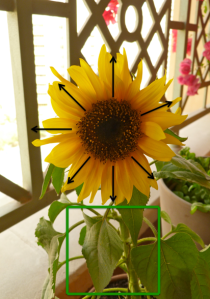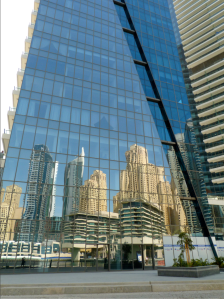From my already-taken photographs, choose a small selection and decide how the balance works in each.
At the heart of composition lies the concept of balance. Balance is when opposing forces are equalised, providing equilibrium and a sense of harmony.
In photography, balance can refer to any of the graphic elements in a photograph such as objects, points, lines, colours and backgrounds, and the way they are arranged so to find the visual “centre of gravity.”
Freeman defines two distinct types of balance; symmetrical and dynamic. Symmetrical balance is when the arrangement of forces is centred. Using a weighing scale analogy, this static balance can be illustrated by showing an object, or objects, sitting over the fulcrum, the point of balance, as below.
Dynamic balance concerns opposing and unequal weights and forces. Returning to the weighing scale, this could be demonstrated by a large object balanced by a small object, provided the smaller object is placed far enough away from the fulcrum.
Dynamic balance concerns opposing and unequal weights and forces. Returning to the weighing scale, this could be demonstrated by a large object balanced by a small object, provided the smaller object is placed far enough away from the fulcrum.
I will now decide how the balance works in a selection of my own photographs, and use the ‘weighing scale’ to illustrate this.
This image has the tower positioned centrally over the weighing scale’s fulcrum. This provides a simple example of symmetrical, or static, balance.
Maximum symmetry occurs when an object or lines radiate around the frame’s centre giving symmetry on all axes, as is the case with the sunflower image below.
This photograph also demonstrates maximum symmetry as the lines of the petals extend around the centre. The pink of the petals is also balanced by the complementary green tones of the background.
This photograph shows a lodge which is occupying a large area in the right of the frame. There are several trees, but I consider the tall tree on the left, with the denser foliage to be the other dominant feature in this image. When placed on the weighing scale the opposing sizes and shapes of these objects provide dynamic balance.
This image shows a residential tower offering reflective views of its immediate surroundings. The main elements of the image that struck me were the dominant diagonal lines, some of which are implied due to the short focal length used, 25mm efl, and close position. I used these lines to imagine a triangle which converged just beyond the frame edge.
On the weighing scale the base of triangle is stable over the fulcrum resulting in symmetrical balance. However, diagonal lines introduce dynamism into an image. They are considered active with a strong sense of direction (Freeman, p76). So while this image is symmetrically balanced, the diagonals provide dynamic tension and interest.
This image had more elements in the frame to consider than the other examples I have used. It approached it several ways before deciding on the balance to be dynamic. The hammock, tiered on top with the rowing boat and the land in the distance to provide an unstable stepping stone arrangement. The small glimpse of machinery on the far right of the frame balances this image dynamically.
On reflection this exercise was easier to carry out with simply composed photographs, containing fewer elements. When the number of elements increased the balance became less obvious. This was evident as I examined image 7 and considered if the hammock in the foreground was more distinct than the boat just beyond. Which is possibly a question that other viewers would ask too.
The weighing scale analogy I have used above demonstrates the ground rules for visual balance on a very basic level. Balance can bring harmony to an image, however it should be considered if harmony and balance is always advisable. If photographs were constantly balanced in composition there would be little for the viewer to search for. It is worth considering if asymmetric balance would engage the viewer’s interest further and on the whole provide a more interactive experience?























